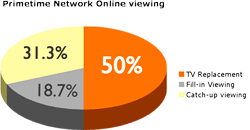 According to the latest Pew Research study, the Internet (in the U.S.) has overtaken Newspapers as a primary news source, Television next?
According to the latest Pew Research study, the Internet (in the U.S.) has overtaken Newspapers as a primary news source, Television next?
The internet, which emerged this year as a leading source for campaign news, has now surpassed all other media except television as a main source for national and international news.Currently, 40% say they get most of their news about national and international issues from the internet, up from just 24% in September 2007. For the first time in a Pew survey, more people say they rely mostly on the internet for news than cite newspapers (35%). Television continues to be cited most frequently as a main source for national and international news, at 70%.For young people, however, the internet now rivals television as a main source of national and international news. Nearly six-in-ten Americans younger than 30 (59%) say they get most of their national and international news online; an identical percentage cites television. In September 2007, twice as many young people said they relied mostly on television for news than mentioned the internet (68% vs. 34%).
via pew

